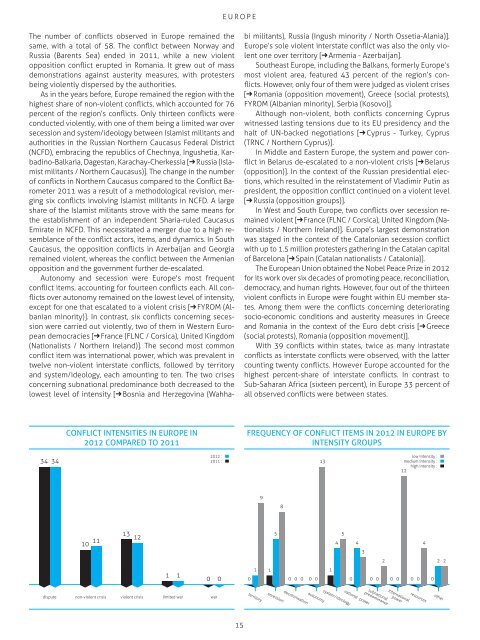ConflictBarometer_2012
ConflictBarometer_2012
ConflictBarometer_2012
Create successful ePaper yourself
Turn your PDF publications into a flip-book with our unique Google optimized e-Paper software.
EUROPE<br />
The number of conflicts observed in Europe remained the<br />
same, with a total of 58. The conflict between Norway and<br />
Russia (Barents Sea) ended in 2011, while a new violent<br />
opposition conflict erupted in Romania. It grew out of mass<br />
demonstrations against austerity measures, with protesters<br />
being violently dispersed by the authorities.<br />
As in the years before, Europe remained the region with the<br />
highest share of non-violent conflicts, which accounted for 76<br />
percent of the region’s conflicts. Only thirteen conflicts were<br />
conducted violently, with one of them being a limited war over<br />
secession and system/ideology between Islamist militants and<br />
authorities in the Russian Northern Caucasus Federal District<br />
(NCFD), embracing the republics of Chechnya, Ingushetia, Karbadino-Balkaria,<br />
Dagestan, Karachay-Cherkessia [1 Russia (Islamist<br />
militants / Northern Caucasus)]. The change in the number<br />
of conflicts in Northern Caucasus compared to the Conflict Barometer<br />
2011 was a result of a methodological revision, merging<br />
six conflicts involving Islamist militants in NCFD. A large<br />
share of the Islamist militants strove with the same means for<br />
the establishment of an independent Sharia-ruled Caucasus<br />
Emirate in NCFD. This necessitated a merger due to a high resemblance<br />
of the conflict actors, items, and dynamics. In South<br />
Caucasus, the opposition conflicts in Azerbaijan and Georgia<br />
remained violent, whereas the conflict between the Armenian<br />
opposition and the government further de-escalated.<br />
Autonomy and secession were Europe's most frequent<br />
conflict items, accounting for fourteen conflicts each. All conflicts<br />
over autonomy remained on the lowest level of intensity,<br />
except for one that escalated to a violent crisis [1 FYROM (Albanian<br />
minority)]. In contrast, six conflicts concerning secession<br />
were carried out violently, two of them in Western European<br />
democracies [1 France (FLNC / Corsica), United Kingdom<br />
(Nationalists / Northern Ireland)]. The second most common<br />
conflict item was international power, which was prevalent in<br />
twelve non-violent interstate conflicts, followed by territory<br />
and system/ideology, each amounting to ten. The two crises<br />
concerning subnational predominance both decreased to the<br />
lowest level of intensity [1 Bosnia and Herzegovina (Wahhabi<br />
militants), Russia (Ingush minority / North Ossetia-Alania)].<br />
Europe’s sole violent interstate conflict was also the only violent<br />
one over territory [1 Armenia - Azerbaijan].<br />
Southeast Europe, including the Balkans, formerly Europe’s<br />
most violent area, featured 43 percent of the region’s conflicts.<br />
However, only four of them were judged as violent crises<br />
[1 Romania (opposition movement), Greece (social protests),<br />
FYROM (Albanian minority), Serbia (Kosovo)].<br />
Although non-violent, both conflicts concerning Cyprus<br />
witnessed lasting tensions due to its EU presidency and the<br />
halt of UN-backed negotiations [1 Cyprus - Turkey, Cyprus<br />
(TRNC / Northern Cyprus)].<br />
In Middle and Eastern Europe, the system and power conflict<br />
in Belarus de-escalated to a non-violent crisis [1 Belarus<br />
(opposition)]. In the context of the Russian presidential elections,<br />
which resulted in the reinstatement of Vladimir Putin as<br />
president, the opposition conflict continued on a violent level<br />
[1 Russia (opposition groups)].<br />
In West and South Europe, two conflicts over secession remained<br />
violent [1 France (FLNC / Corsica), United Kingdom (Nationalists<br />
/ Northern Ireland)]. Europe’s largest demonstration<br />
was staged in the context of the Catalonian secession conflict<br />
with up to 1.5 million protesters gathering in the Catalan capital<br />
of Barcelona [1 Spain (Catalan nationalists / Catalonia)].<br />
The European Union obtained the Nobel Peace Prize in <strong>2012</strong><br />
for its work over six decades of promoting peace, reconciliation,<br />
democracy, and human rights. However, four out of the thirteen<br />
violent conflicts in Europe were fought within EU member states.<br />
Among them were the conflicts concerning deteriorating<br />
socio-economic conditions and austerity measures in Greece<br />
and Romania in the context of the Euro debt crisis [1 Greece<br />
(social protests), Romania (opposition movement)].<br />
With 39 conflicts within states, twice as many intrastate<br />
conflicts as interstate conflicts were observed, with the latter<br />
counting twenty conflicts. However Europe accounted for the<br />
highest percent-share of interstate conflicts. In contrast to<br />
Sub-Saharan Africa (sixteen percent), in Europe 33 percent of<br />
all observed conflicts were between states.<br />
Conflict Intensities in Europe in<br />
<strong>2012</strong> compared to 2011<br />
Frequency of Conflict Items in <strong>2012</strong> in Europe by<br />
Intensity Groups<br />
34<br />
34<br />
<strong>2012</strong> :<br />
2011 :<br />
13<br />
low Intensity :<br />
medium Intensity :<br />
high Intensity :<br />
12<br />
9<br />
8<br />
13 12<br />
1<br />
10<br />
11<br />
5<br />
5<br />
4 4<br />
4<br />
3<br />
2<br />
1<br />
0 0 0 0 0<br />
0 0 0 0 0 0 0<br />
2 2<br />
1<br />
0 0<br />
1<br />
0<br />
1<br />
0<br />
dispute non-violent crisis violent crisis limited war war<br />
territory<br />
international<br />
power<br />
subnational<br />
predominance<br />
resources<br />
other<br />
system / ideology<br />
autonomy<br />
decolonisation<br />
secession<br />
national power<br />
15


